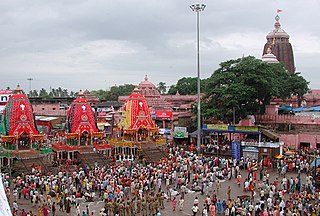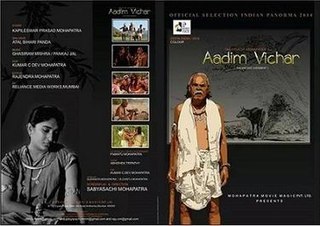
Jagannatha is a deity worshipped in regional Hindu traditions in India as part of a triad along with his (Krishna's) brother Balabhadra, and sister, Subhadra. Jagannath, within Odia Hinduism, is the supreme god, Purushottama, and the Para Brahman. To most Vaishnava Hindus, particularly the Krishnaites, Jagannath is an abstract representation of Krishna, or Vishnu, sometimes as the avatar of Krishna or Vishnu. To some Shaiva and Shakta Hindus, he is a symmetry-filled tantric form of Bhairava, a fierce manifestation of Shiva associated with annihilation.

The Ratha Yatraof Puri, also rendered as the Ratha Jatra, is considered the oldest and largest Hindu chariot festival celebrated annually, on the bright half of the lunar month of Ashadh (June–July). The festival is held at the city of Puri, in the state of Odisha, India and associated with the deity Jagannath. During the festival, three deities are drawn by a multitude of devotees in three massive, wooden chariots on bada danda to Gundicha Temple whereby they reside there for a week and then return to the Jagnannath temple. This return trip is referred to as the Bahuda Yatra.

Puri is a coastal city and a municipality in the state of Odisha in eastern India. It is the district headquarters of Puri district and is situated on the Bay of Bengal, 60 kilometres (37 mi) south of the state capital of Bhubaneswar. It is home to the 12th-century Jagannath Temple and is one of the original Char Dham pilgrimage sites for Hindus.

The Jagannath Temple is an important Hindu temple dedicated to Jagannath, a form of Vishnu–one of the trinity of supreme divinity in Hinduism. It is located in Puri in the state of Odisha, situated on the eastern coast of India. As per temple records, King Indradyumna of Avanti built the main temple of Jagannath at Puri. The present temple was rebuilt from the tenth century onwards, on the site of the pre-existing temples in the compound, but not the main Jagannath temple, and begun by Anantavarman Chodaganga, the first king of the Eastern Ganga dynasty. Many of the temple rituals are based on Oddiyana Tantras which are the refined versions of Mahayana Tantras as well as Shabari Tantras which are evolved from Tantric Buddhism and tribal beliefs respectively. The local legends link the idols with aboriginal tribes and the daitapatis (servitors) claim to be descendants of the aboriginals. The temple is one of the 108 Abhimana Kshethram of the Vaishnavite tradition.
The Odia (ଓଡ଼ିଆ), formerly spelled Oriya, are an Indo-Aryan ethnic group native to the Indian state of Odisha who speak the Odia language. They constitute a majority in the eastern coastal state, with significant minority populations existing in the neighboring states of Andhra Pradesh, Chhattisgarh, Jharkhand and West Bengal.
The Madala Panji is a chronicle of the Jagannath Temple, Puri, Odisha, India. It describes the historical events of Odisha related to Lord Jagannath and the Jagannath Temple. The Madala Panji dates from the 12th century.
Odia literature is literature written in the Odia language, mostly from the Indian state of Odisha. The modern Odia language is mostly formed from Tadbhava words with significant Sanskrit (Tatsama) influences, along with loanwords from Desaja, English, Hindustani (Hindi/Urdu), Persian, and Arabic. Its earliest written texts date from around 1000 CE. The earliest Odia newspaper was Utkala Deepika, first published on August 4, 1866.
The Lakshmi Purana is an Odia text written in the 15th century by Balarama Dasa, a major poet of Odia literature. Despite its name, it is not one of the eighteen major Puranas of Hinduism, having been written in the medieval era as a piece of regional literature that discusses gender and social norms.

MahapurusaAchyutananda Dasa (Odia:-ଅଚ୍ୟୁତାନନ୍ଦ ଦାସ ) was a 16th-century poet seer and Vaishnava saint from Odisha, India. He was popularly known as Gopala Guru. He was considered to have the power to see the past, present and future. He was a prolific author, and one of the group of five, that led a revolution in spirituality in Odisha by translating Sanskrit texts into the Odia language for common people.
Odisha is one of the 28 states of India, located on the eastern coast. It is surrounded by the states of West Bengal to the northeast, Jharkhand to the north, Chhattisgarh to the west and northwest, and Andhra Pradesh to the south and southwest. Odia is the official and most widely spoken language, spoken by 33.2 million according to the 2001 Census. The modern state of Odisha was established on 1 April 1936, as a province in British India, and consisted predominantly of Odia-speaking regions. April 1 is celebrated as Odisha Day.

The Odia cinema, colloquially known as Ollywood, is the Odia language Indian film industry, based in Bhubaneshwar and Cuttack in Odisha, India. The name Ollywood is a portmanteau of the words Odia and Hollywood.

Gundicha Temple, is a Hindu temple, situated in the temple town of Puri in the state of Odisha, India. It is significant for being the destination of the celebrated annual Rath Yatra of Puri. While it remains vacant most of the year, the temple is occupied by images of the deities of Jagannath, his brother Balabhadra and sister Subhadra for seven complete days every year during the annual Rath Yatra festival.

Tarang Television, commonly known as Tarang TV is an Odia-language based general entertainment television channel. Based in Bhubaneswar, India, it is owned by Odisha Television Ltd. Tarang is a digitally encrypted 24x7 Odia entertainment channel. It gives viewers family entertainment ranging from family shows to period drama and reality shows. Tarang TV's programming is targeted towards family audiences.

Sabyasachi Mohapatra is an Indian film director, writer, and producer in Odia cinema. He owns a production house named Mohapatra Movie Magic.
Manohar Meher was an Indian Odia language poet. He is regarded as Gana-Kavi or Palli-Kavi of Western Odisha in the arena of Odia literature. Born on the sacred day of SriRama-Navami of 1885 A.D., Poet Manohar died on 4 December 1969. He has written numerous poems related to Indian heritage, patriotism, social reformation, Odia culture and other similar matters. His complete works named as Manohar Granthavali is yet to be published.

Sala Budha is a 2012 Indian Kosli language feature film directed by Sabyasachi Mohapatra. The film had won awards in seven categories at Odisha State Film Awards including best film and best director.

Mānabasā Gurubāra is a festival celebrated by Odia Hindus in the East Indian state of Odisha. It is also celebrated by Odias living in Andhra Pradesh, Chhattisgarh, South Jharkhand and South West Bengal. In this festival Goddess Mahalaxmi is the presiding deity. It is believed by the people that the goddess herself comes to every household and removes pain and sorrow. It is held on every Thursday in the month of Margasira.
Pahada Ra Luha is a 2015 Indian Sambalpuri language feature film directed by Sabyasachi Mohapatra. The film has won 63rd National Film Awards for Best Feature Film in Odia category.

Aadim Vichar is a 2014 Indian Sambalpuri language drama film directed by Sabyasachi Mohapatra. The film won 62nd National Film Award for Best Feature Film in Odia and is a sequel to the 2012 movie "Sala Budha". Atal Bihari Panda and Sushree Smita Panda played lead roles in the film.












